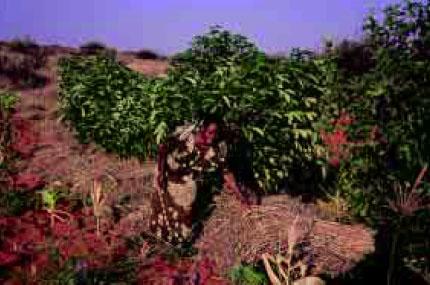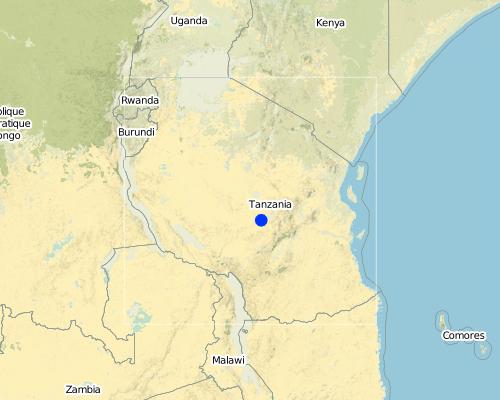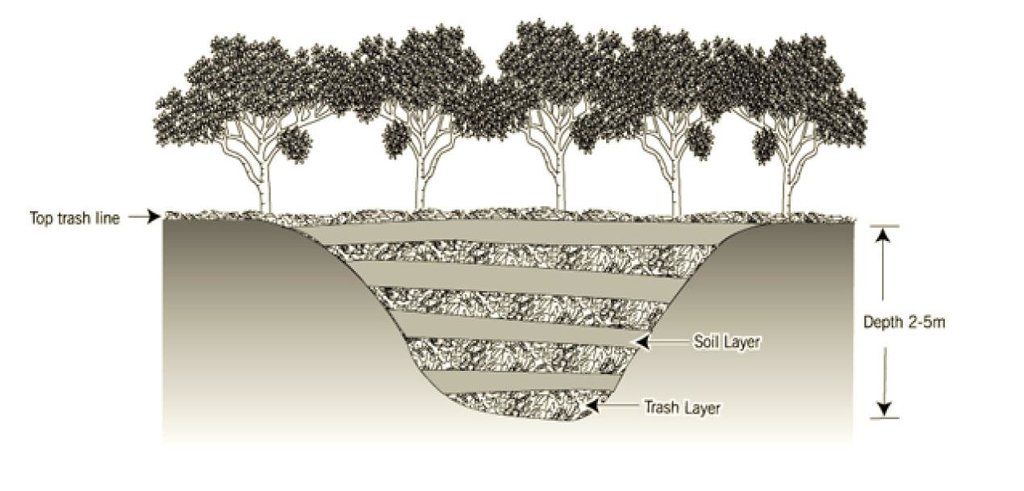Gully healing using trash lines [Tanzania, United Republic of]
- Creation:
- Update:
- Compiler: Patrick Gervas Mbanguka Lameck
- Editor: –
- Reviewer: David Streiff
Kingamaji la nyasi
technologies_1393 - Tanzania, United Republic of
View sections
Expand all Collapse all1. General information
1.2 Contact details of resource persons and institutions involved in the assessment and documentation of the Technology
Name of the institution(s) which facilitated the documentation/ evaluation of the Technology (if relevant)
Inades Formation Tanzania (Inades Formation Tanzania)1.3 Conditions regarding the use of data documented through WOCAT
When were the data compiled (in the field)?
24/02/2011
The compiler and key resource person(s) accept the conditions regarding the use of data documented through WOCAT:
Yes
2. Description of the SLM Technology
2.1 Short description of the Technology
Definition of the Technology:
Gully healing using trash lines reinforced by pegs
2.2 Detailed description of the Technology
Description:
The starting point is to form a layer of trash and soil across the bed of the gully (a typical gully here is 3-10 m wide, and 2 m or more deep), reinforced with
pegs, and to build this up gradually in layers as sediment is captured behind it. On top of the barrier a dense line of mikayeba (tree cassava: Manihot glaziovii) is planted. Trash continues to be added to the nowliving barrier until the gully is fully silted up. The barrier, 1 – 2 metres wide, then appears as a contour line
across her land, and continues to function against erosion. Mikayeba is not just a living structural support: its leaves are also a source of fresh vegetables. Where the gullies are more severe, she is testing cuttings of Commiphora africana.
Purpose of the Technology: The purpose of the technology is reclamation of land from gullies for plant production. Impact is achieved through impeding concentrated runoff and capturing sediment.
Establishment / maintenance activities and inputs: The treatment does not end with sedimentation of the gully bed. The land is left fallow for one to two seasons. Then, late in the first or second season, the farmer digs in the young volunteer vegetation as a green manure, and plants a ‘catch crop’ of maize. If it produces cobs, well and good. If not, she feeds the
plants to her stall-fed cows. The main maintenance aspect is the continuous addition of soil/trash layer upon previous layers, and tending the living barrier to maintain its density. Maintenance, as well as original establishment, requires
only common farm/household tools including hoes, spades, sacks and pangas.
Natural / human environment: Grace is in her early 50s, and though her farm of 3 hectares is not larger than normal, her homestead buildings indicate that she is rather above average in terms of wealth. This is something she has achieved through her own efforts. Grace has become the main farmer in the family. Her husband is a retired
teacher and professes no interest in developing the land further. In 1982 Grace acquired, and decided to reclaim, some badly gullied land.
2.3 Photos of the Technology
2.5 Country/ region/ locations where the Technology has been applied and which are covered by this assessment
Country:
Tanzania, United Republic of
Further specification of location:
Dodoma/Dodoma rural
Map
×2.6 Date of implementation
If precise year is not known, indicate approximate date:
- less than 10 years ago (recently)
2.7 Introduction of the Technology
Specify how the Technology was introduced:
- through land users' innovation
Comments (type of project, etc.):
farmer innovation
3. Classification of the SLM Technology
3.1 Main purpose(s) of the Technology
- reduce, prevent, restore land degradation
3.2 Current land use type(s) where the Technology is applied

Cropland
- Annual cropping
- Perennial (non-woody) cropping
- Tree and shrub cropping
Main crops (cash and food crops):
major cash crop: Groundnuts (CA) and pigeon peas (PA)
major food crop: Maize (CA) and Bananans (PA)
other (CA): Sorghum and millet
Comments:
Major land use problems (compiler’s opinion): formation of new gullies and expansion of the existing ones
Major land use problems (land users’ perception): same as above
3.3 Further information about land use
Number of growing seasons per year:
- 1
Specify:
Longest growing period in days: 120; Longest growing period from month to month: Dec - Apr
3.4 SLM group to which the Technology belongs
- improved ground/ vegetation cover
- cross-slope measure
3.5 Spread of the Technology
Specify the spread of the Technology:
- evenly spread over an area
If the Technology is evenly spread over an area, indicate approximate area covered:
- < 0.1 km2 (10 ha)
3.6 SLM measures comprising the Technology

agronomic measures

structural measures

management measures
Comments:
Main measures: structural measures
Secondary measures: agronomic measures, management measures
3.7 Main types of land degradation addressed by the Technology

soil erosion by water
- Wg: gully erosion/ gullying

chemical soil deterioration
- Cn: fertility decline and reduced organic matter content (not caused by erosion)

water degradation
- Ha: aridification
Comments:
Secondary types of degradation addressed: Cn: fertility decline and reduced organic matter content, Ha: aridification
3.8 Prevention, reduction, or restoration of land degradation
Specify the goal of the Technology with regard to land degradation:
- reduce land degradation
Comments:
Secondary goals: prevention of land degradation, mitigation / reduction of land degradation
4. Technical specifications, implementation activities, inputs, and costs
4.1 Technical drawing of the Technology
4.2 Technical specifications/ explanations of technical drawing
Cross-section through a healed gully
Tanzania
Technical knowledge required for field staff / advisors: high
Technical knowledge required for land users: low
Secondary technical functions: control of concentrated runoff: retain / trap, increase in organic matter
Structural measure: other
Vertical interval between structures (m): 1
Spacing between structures (m): 20
Height of bunds/banks/others (m): 0.4
Width of bunds/banks/others (m): 2
Construction material (earth): layer of earth line 0.3m thick
Slope (which determines the spacing indicated above): 5.00%
If the original slope has changed as a result of the Technology, the slope today is: 2.00%
Lateral gradient along the structure: 2.50%
4.3 General information regarding the calculation of inputs and costs
Specify currency used for cost calculations:
- US Dollars
Indicate average wage cost of hired labour per day:
1.90
4.4 Establishment activities
| Activity | Type of measure | Timing | |
|---|---|---|---|
| 1. | putting atrash line on the gully bed | Structural | establishment |
| 2. | establishment | Structural | establishment |
| 3. | putting layers of soil | Structural | establishment |
4.5 Costs and inputs needed for establishment
| Specify input | Unit | Quantity | Costs per Unit | Total costs per input | % of costs borne by land users | |
|---|---|---|---|---|---|---|
| Labour | Establishment | persons/day/ha | 821.0 | 1.9 | 1559.9 | 100.0 |
| Equipment | Animal traction | ha | 1.0 | 10.6 | 10.6 | 100.0 |
| Plant material | Seeds | ha | 1.0 | 9.0 | 9.0 | 100.0 |
| Total costs for establishment of the Technology | 1579.5 | |||||
Comments:
Duration of establishment phase: 60 month(s)
4.6 Maintenance/ recurrent activities
| Activity | Type of measure | Timing/ frequency | |
|---|---|---|---|
| 1. | replace the decomposed trash | Structural | before rains/each cropping season |
| 2. | incorporate the trash | Structural | before rains/each cropping season |
4.7 Costs and inputs needed for maintenance/ recurrent activities (per year)
| Specify input | Unit | Quantity | Costs per Unit | Total costs per input | % of costs borne by land users | |
|---|---|---|---|---|---|---|
| Labour | Replace and incorporate trash | persons/day/ha | 51.5 | 1.9 | 97.85 | 100.0 |
| Equipment | Animal traction | ha | 1.0 | 10.6 | 10.6 | 100.0 |
| Plant material | Seeds | ha | 1.0 | 9.0 | 9.0 | 100.0 |
| Total costs for maintenance of the Technology | 117.45 | |||||
Comments:
Machinery/ tools: hoes, spade, matchet and sack
labour hired
4.8 Most important factors affecting the costs
Describe the most determinate factors affecting the costs:
gully depth and slope
5. Natural and human environment
5.1 Climate
Annual rainfall
- < 250 mm
- 251-500 mm
- 501-750 mm
- 751-1,000 mm
- 1,001-1,500 mm
- 1,501-2,000 mm
- 2,001-3,000 mm
- 3,001-4,000 mm
- > 4,000 mm
Agro-climatic zone
- semi-arid
- arid
5.2 Topography
Slopes on average:
- flat (0-2%)
- gentle (3-5%)
- moderate (6-10%)
- rolling (11-15%)
- hilly (16-30%)
- steep (31-60%)
- very steep (>60%)
Landforms:
- plateau/plains
- ridges
- mountain slopes
- hill slopes
- footslopes
- valley floors
Altitudinal zone:
- 0-100 m a.s.l.
- 101-500 m a.s.l.
- 501-1,000 m a.s.l.
- 1,001-1,500 m a.s.l.
- 1,501-2,000 m a.s.l.
- 2,001-2,500 m a.s.l.
- 2,501-3,000 m a.s.l.
- 3,001-4,000 m a.s.l.
- > 4,000 m a.s.l.
Comments and further specifications on topography:
Slopes on average: Also rolling and hilly
Landforms: Also mountain and footslopes and valley floors
5.3 Soils
Soil depth on average:
- very shallow (0-20 cm)
- shallow (21-50 cm)
- moderately deep (51-80 cm)
- deep (81-120 cm)
- very deep (> 120 cm)
Soil texture (topsoil):
- coarse/ light (sandy)
- medium (loamy, silty)
Topsoil organic matter:
- medium (1-3%)
- low (<1%)
If available, attach full soil description or specify the available information, e.g. soil type, soil PH/ acidity, Cation Exchange Capacity, nitrogen, salinity etc.
Soil depth on average: Also moderately deep
Soil fertility is low, medium and very low
Soil drainage / infiltration is medium
Soil water storage capacity is low - medium
5.6 Characteristics of land users applying the Technology
Market orientation of production system:
- subsistence (self-supply)
- mixed (subsistence/ commercial
Off-farm income:
- 10-50% of all income
Relative level of wealth:
- poor
- average
Indicate other relevant characteristics of the land users:
50% of the land users are average wealthy and own 70% of the land.
30% of the land users are poor and own 20% of the land.
20% of the land users are poor and own 10% of the land.
Off-farm income specification: local brewing making, charcoal burning, beekeeping and ornament making
5.8 Land ownership, land use rights, and water use rights
Land ownership:
- communal/ village
6. Impacts and concluding statements
6.1 On-site impacts the Technology has shown
Socio-economic impacts
Production
crop production
fodder production
wood production
production area
Income and costs
farm income
Other socio-economic impacts
area of gullies
Socio-cultural impacts
community institutions
national institutions
SLM/ land degradation knowledge
Ecological impacts
Water cycle/ runoff
surface runoff
Quantity before SLM:
85
Quantity after SLM:
40
excess water drainage
Soil
soil moisture
soil cover
soil loss
Climate and disaster risk reduction
wind velocity
Other ecological impacts
soil fertility
biodiversity
6.2 Off-site impacts the Technology has shown
downstream flooding
downstream siltation
wind transported sediments
6.4 Cost-benefit analysis
How do the benefits compare with the establishment costs (from land users’ perspective)?
Short-term returns:
very positive
Long-term returns:
very positive
How do the benefits compare with the maintenance/ recurrent costs (from land users' perspective)?
Short-term returns:
very positive
Long-term returns:
very positive
6.5 Adoption of the Technology
- single cases/ experimental
If available, quantify (no. of households and/ or area covered):
4 households covering 10 percent of stated area (1 percent of all households)
Of all those who have adopted the Technology, how many have did so spontaneously, i.e. without receiving any material incentives/ payments?
- 90-100%
Comments:
4 land user families have adopted the Technology without any external material support
Comments on spontaneous adoption: survey results
There is a little trend towards spontaneous adoption of the Technology
Comments on adoption trend: production of good crops by the gully attract other people
6.7 Strengths/ advantages/ opportunities of the Technology
| Strengths/ advantages/ opportunities in the land user’s view |
|---|
| same as above |
| Strengths/ advantages/ opportunities in the compiler’s or other key resource person’s view |
|---|
|
suited to local conditions How can they be sustained / enhanced? select more durable materials. |
|
improves soil moisture How can they be sustained / enhanced? grow vertiver grass in the upper sections |
6.8 Weaknesses/ disadvantages/ risks of the Technology and ways of overcoming them
| Weaknesses/ disadvantages/ risks in the compiler’s or other key resource person’s view | How can they be overcome? |
|---|---|
| takes too long before the returns | grow crops as live barriers |
| tough job | make use of improve tools |
| conflict with livestock keepers | make use of local administration to arbitrate |
7. References and links
7.2 References to available publications
Title, author, year, ISBN:
1st farmers innovation workshop report
Available from where? Costs?
INADES tanzania
Title, author, year, ISBN:
Kithinji M., Critchley W. 2001. Farmers' initiatives in land husbandry: Promising technologies for the drier areas of East Africa. RELMA Technical Report series no. 27
Links and modules
Expand all Collapse allLinks
No links
Modules
No modules





